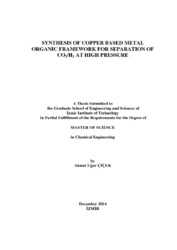Please use this identifier to cite or link to this item:
https://hdl.handle.net/11147/4312| Title: | Synthesis of Copper based metal organic framework for separation of CO2/H2 at high pressure | Other Titles: | Yüksek basınçta CO2/H2 ayrımı için bakır bazlı metal organik ağ yapısının sentezlenmesi | Authors: | Çiçek, Ahmet Uğur | Advisors: | Çakicioğlu Özkan, Seher Fehime | Keywords: | Metal organic framework Copper terephthalate Gas separation Hydrogen |
Publisher: | Izmir Institute of Technology | Source: | Çiçek, A. U. (2014). Synthesis of Copper based metal organic framework for separation of CO2/H2 at high pressure. Unpublished master's thesis, Izmir Institute of Technology, Izmir, Turkey | Abstract: | In this study, synthesis of Copper based metal organic framework (CuTPA) was achieved. Terephthalic acids were used as an organic linkers supplied from PETKİM A.Ş. Synthesis procedure was carried out in three steps; crystallization, purification and activation with different parameters. Crystallization time and temperature, purification method and solvent type , thermal activation rate are studied. MOFs were characterized by using SEM (Scanning Electron Microscopy), Fourier Transformer Infrared (FTIR), Thermal Gravimetric Analyzer (TGA), X-ray Diffractometer (XRD), and Volumetric Adsorption Instrument (ASAP 2010). The CuTPA with the highest specific surface area (SLang=776 m2/g) was synthesized after purification with methanol by soxhlet method in a schott bottle for 24 hours at crystallization temperature of 110 oC. Copper based MOF synthesized (SLang=776 m2/g) and Commercial NaX zeolite (SLang= 1359 m2/g) were packed in the column. Dynamic adsorption behavior of adsorbents was also studied; breakthrough of CO2/H2 and gases from the packed bed were carried out under total molar flow rate of 10, 20, and 30 mL/min gas mixture at 1, 5, and, 10 bars. It was conclude that the adsorption data results obtained from our system is reliable. As a result of breakthrough experiment both adsorbents (CuTPA and 13X zeolite) did not adsorbed H2. The break points are increased with increasing pressure and decreasing total flow rate. The amount to be adsorbed by the adsorbent in the column is increased indicating that the adsorption mechanism, controlling mechanism is changed with decreasing total flow rate. | Description: | Thesis (Master)--Izmir Institute of Technology, Chemical Engineering, Izmir, 2014 Full text release delayed at author's request until 2018.01.19 Includes bibliographical references (leaves: 69-76) Text in English; Abstract: Turkish and English xii, 76 leaves |
URI: | http://hdl.handle.net/11147/4312 |
| Appears in Collections: | Master Degree / Yüksek Lisans Tezleri |
Files in This Item:
| File | Description | Size | Format | |
|---|---|---|---|---|
| T001317.pdf | MasterThesis | 4.04 MB | Adobe PDF |  View/Open |
CORE Recommender
Page view(s)
118
checked on Jul 15, 2024
Download(s)
148
checked on Jul 15, 2024
Google ScholarTM
Check
Items in GCRIS Repository are protected by copyright, with all rights reserved, unless otherwise indicated.